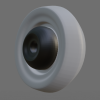Table of Contents
Chemical Rocket Engines
Fuel Types
For a typical chemical rocket, the fuel and propellant are the same thing. For Nuclear rockets the fuel and propellant are different things. The fuel powers the reactor, and the propellant is thrown out the back.
See:
Kerolox
Density: 14
Max Impulse: 4.7
Liquid Oxygen and RP-1. Denser and requires less cryogenic cooling than liquid hydrogen.
Hydrolox
Density: 4
Max Impulse: 5.3
Liquid Oxygen and Liquid Hydrogen. Very low density but high efficiency without being insanely dangerous. The cryogenic needs complicate things though.
Methalox
Density: 10
Max Impulse: 4.6
Liquid methane and liquid oxygen.
Liquid Hydrogen
Density: 1
Impulse: ~
Generally used as propellant in nuclear or plasma engines.
TL 8 Engines (Modern Day)
The following drive types are based on real technology, simplified for purposes of the game.
| Engine | dT | Mass (t) | Thrust | Impulse | Fuel Type | Density | Environment |
|---|---|---|---|---|---|---|---|
| Merlin/a | ¼ | 0.5 | 850 | 2.8 | Kerolox | 14 | Atmosphere |
| Merlin/v | ½ | 1.0 | 980 | 3.1 | Kerolox | 14 | Vacuum |
| Raptor/a | ½ | 1.5 | 1,960 | 3.3 | Methalox | 10 | Atmosphere |
| Raptor/v | 1 | 2.5 | 2,150 | 3.5 | Methalox | 10 | Vacuum |
| F-1/a | 2 | 8.4 | 6,770 | 2.6 | Kerolox | 14 | Atmosphere |
TL 9 Engines (Plausible Future)
RCS
Small reaction-control thrusters designed for attitude control and fine manoeuvring. They often have poor impulse and very low thrust. There will often be multiple such engines arranged around a craft.

| Engine | dT | Mass (t) | Thrust | Impulse | Fuel Type | Density | Environment |
|---|---|---|---|---|---|---|---|
| Linear RCS | ⅛ | 1 | 200 | 3.4 | Mono | 12 | Vacuum |
| RCS | ⅛ | 1 | 100 | 3.2 | Mono | 12 | Vacuum |
Standard Engines
Typical bell nozzle designs. There are two variants - vacuum and atmospheric. The latter are optimised for use at sea level.
| Engine | dT | Mass (t) | Thrust | Impulse | Fuel Type | Density | Environment |
|---|---|---|---|---|---|---|---|
| RD-4/a | ¼ | 1 | 900 | 3.8 | Kerolox | 14 | Atmosphere |
| RD-4/a | ¼ | 1 | 900 | 4.1 | Kerolox | 14 | Vacuum |
| RD-4/v | 1 | 2 | 1,000 | 4.5 | Kerolox | 14 | Vacuum |
| RD-2/a | ½ | 2.5 | 3,000 | 3.7 | Methalox | 10 | Atmosphere |
| RD-2/a | ½ | 2.5 | 3,000 | 4.0 | Methalox | 10 | Vacuum |
| RD-2/v | 2 | 5 | 3,200 | 4.3 | Methalox | 10 | Vacuum |
Aerospike
| Engine | dT | Mass (t) | Thrust | Impulse | Fuel Type | Density | Environment |
|---|---|---|---|---|---|---|---|
| Aerospike | 1 | 15 | 1,000 | 3.8 | Methalox | 10 | Atmosphere |
| Aerospike | 1 | 15 | 1,000 | 4.5 | Methalox | 10 | Vacuum |
| Aerospike | 3 | 30 | 2,500 | 3.8 | Methalox | 10 | Atmosphere |
| Aerospike | 3 | 30 | 2,500 | 4.5 | Methalox | 10 | Vacuum |
TL 10 Engines
Standard Engines
This is the pinnacle of chemical engines using classic fuels. More exotic fuels are required for any further improvement.
| Engine | dT | Mass (t) | Thrust | Impulse | Fuel Type | Density | Environment |
|---|---|---|---|---|---|---|---|
| RX-2/v | 2 | 4 | 4,000 | 4.5 | Methalox | 10 | Vacuum |
| HX-A/v | 1 | 2 | 2,000 | 5.2 | Hydrolox | 4 | Vacuum |
TL 11 Engines
Monatomic hydrogen engines become available. These are not as efficient as nuclear engines, but are significantly cleaner. The only issue is fuel density is very low. By this point, pretty much all engines are of the aerospike design, since it provides a lot more flexibility and the material/heating problems have been solved.
| Engine | dT | Mass (t) | Thrust | Impulse | Fuel Type | Density | Environment |
|---|---|---|---|---|---|---|---|
| H1-A/v | 2 | 4 | 1,000 | 18 | Hydrogen (H1) | 1 | Vacuum |
